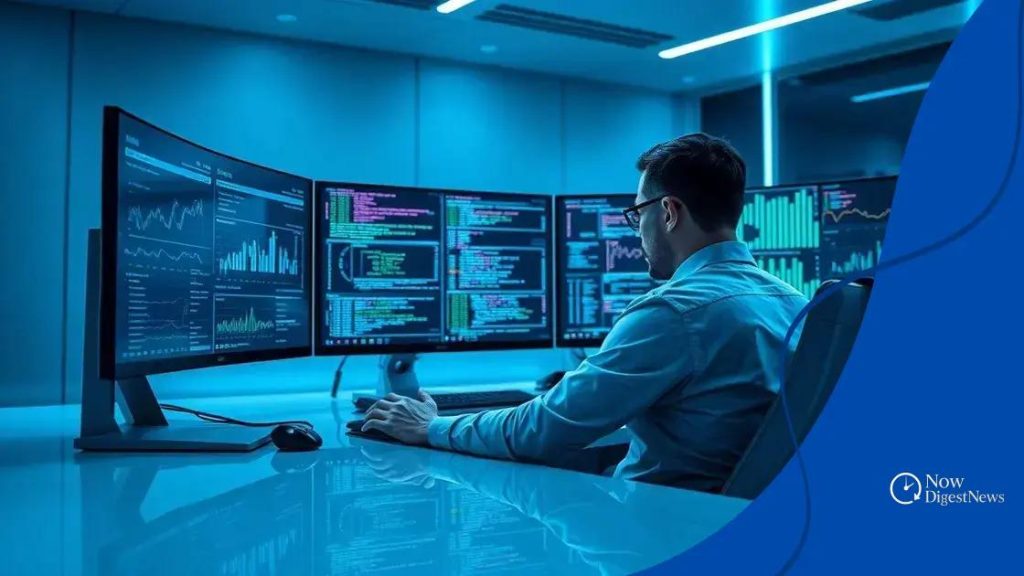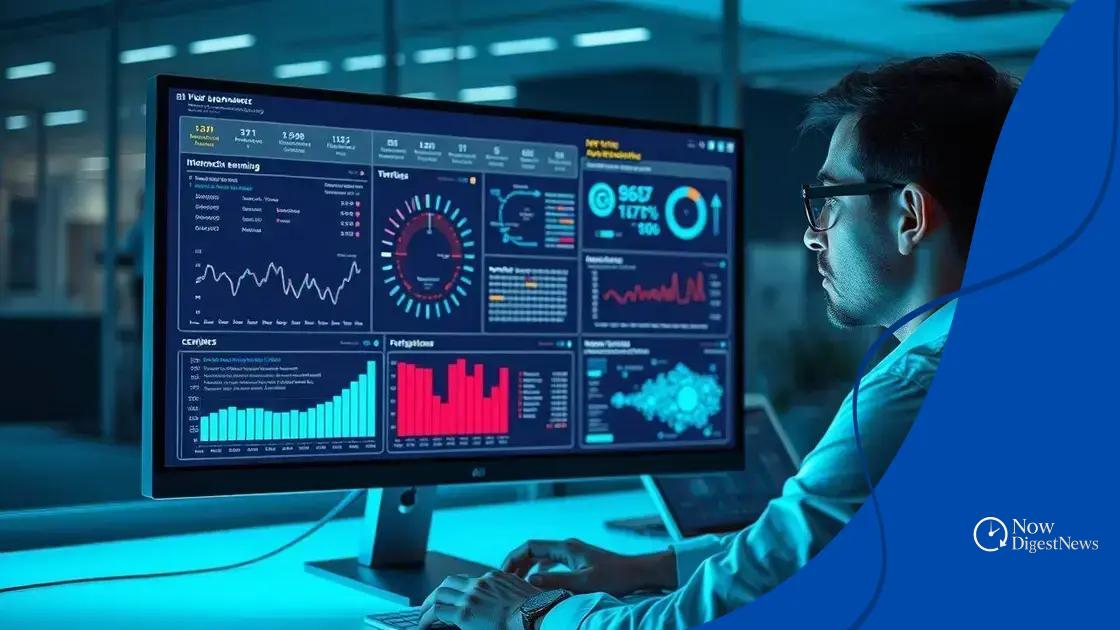AI-driven cybersecurity: securing your digital world

Anúncios
AI-driven cybersecurity utilizes advanced technologies to automate threat detection and response, enhancing security measures against evolving cyber threats while requiring continuous adaptation and human oversight for effective implementation.
AI-driven cybersecurity is shaping the future of digital defense, enhancing how we protect our online resources. But how prepared are we for the challenges ahead? In this article, we’ll dive into the latest trends and tools to ensure your security system stays ahead of the curve.
Anúncios
the impact of AI on cybersecurity
The impact of AI on cybersecurity is profound and increasingly significant as organizations seek effective ways to protect their digital assets. With the rise of cyber threats, it’s essential to understand how artificial intelligence is helping to enhance security measures.
AI technologies can analyze vast amounts of data quickly, identifying patterns and anomalies that would otherwise go unnoticed. By integrating AI into cybersecurity strategies, businesses can react swiftly to threats and bolster their defenses. This approach not only minimizes damage but also streamlines incident response times.
How AI Enhances Cybersecurity
Some of the key ways AI contributes to cybersecurity include:
Anúncios
- Real-time threat detection: AI systems continuously scan for unusual activity, allowing for immediate action against potential threats.
- Predictive analytics: By predicting future risks based on historical data, AI helps organizations stay one step ahead of cyber criminals.
- Automated response: AI can automate responses to specific threats, reducing the burden on human teams and increasing efficiency.
Furthermore, the use of machine learning algorithms enables organizations to improve their security posture consistently. As these systems learn from new data, they adapt and evolve, refining their ability to detect and respond to evolving threats. This continuous improvement cycle ensures that cybersecurity measures remain robust and effective.
It’s also important to note that while AI-driven cybersecurity provides numerous advantages, it also presents its challenges. Some cyber criminals are leveraging AI for malicious purposes, developing sophisticated attacks that can thwart traditional defenses. Therefore, businesses must remain vigilant and continually evolve their strategies to combat these dynamic threats.
Challenges of AI in Cybersecurity
Despite its benefits, AI in cybersecurity faces several challenges:
- False positives: AI systems can sometimes misidentify threats, necessitating manual verification.
- Integration complexities: Integrating AI tools with existing systems can be challenging and resource-intensive.
- Data privacy concerns: The use of sensitive data for training AI models must comply with privacy regulations.
In conclusion, the impact of AI on cybersecurity is reshaping how organizations protect themselves in the digital landscape. By harnessing AI technologies, businesses can enhance their defenses and remain resilient against emerging cyber threats.
emerging threats in the digital landscape
Emerging threats in the digital landscape are continuously evolving, posing significant challenges to organizations striving to protect their sensitive information. As technology advances, cybercriminals are also developing new tactics to exploit vulnerabilities.
One notable trend is the rise of ransomware attacks, where attackers encrypt an organization’s data and demand payment for the decryption key. This type of threat has increased in frequency and sophistication, often targeting large corporations and critical infrastructure.
Types of Emerging Threats
Understanding the various types of threats that are gaining traction can help organizations bolster their defenses. Some key threats include:
- Phishing attacks: These attacks trick individuals into providing sensitive information, often through seemingly legitimate emails.
- IoT vulnerabilities: The growing number of Internet of Things devices creates new entry points for cybercriminals.
- Supply chain attacks: Cyber criminals target less secure elements within a supply chain to compromise larger organizations.
As technology continues to integrate into daily life, threats related to the Internet of Things (IoT) are becoming more prominent. With more devices connected to the internet, the attack surface for malicious actors widens, making it critical for businesses to implement stringent security protocols.
Another significant concern arises from AI-powered attacks. Cybercriminals are using artificial intelligence to automate their tactics, making attacks faster and more difficult to detect. This evolution underscores the need for continual adaptation in cybersecurity measures.
Adapting to New Threats
Organizations must remain vigilant and proactive in adapting to these emerging threats. Implementing regular training sessions for employees on recognizing phishing attempts can significantly reduce risk. Additionally, conducting thorough security assessments and employing advanced security tools can help identify vulnerabilities before they are exploited.
Furthermore, maintaining updated software and security systems is essential to thwart outdated vulnerabilities. In this fast-paced digital world, staying informed about the latest threats and trends is crucial for effective cybersecurity management.
AI tools for enhanced protection

AI tools for enhanced protection are revolutionizing how organizations approach cybersecurity. By harnessing the power of artificial intelligence, businesses can automate threat detection and response, making their security measures more effective.
One of the primary advantages of using AI tools is their ability to analyze large volumes of data in real time. This capability allows organizations to quickly identify unusual patterns that might indicate a security breach. As cyber threats grow more complex, relying on AI becomes a necessity.
Key AI Tools for Cybersecurity
Several AI tools are essential for enhancing cybersecurity, including:
- Machine learning platforms: These tools learn from historical data, improving their accuracy in detecting threats over time.
- Behavioral analytics: By monitoring user behavior, these tools help identify anomalies that could signal a breach.
- Automated threat intelligence: This technology collects and analyzes data from various sources, providing real-time insights into emerging threats.
Another essential AI tool is the use of chatbots. These tools can assist with security queries and help maintain user engagement without human intervention. They can guide users through common security practices, ensuring everyone is informed about safe online behavior.
Additionally, AI-driven firewalls are becoming increasingly sophisticated. Unlike traditional firewalls, these can adapt and respond to new threats by analyzing data patterns and adjusting security protocols in real time. This adaptability makes them a vital part of any security infrastructure.
Benefits of AI-Driven Cybersecurity
The implementation of AI tools can lead to significant benefits for organizations. These include:
- Improved efficiency: Automating routine security tasks allows teams to focus on more complex issues.
- Faster response times: AI can detect and respond to threats far quicker than human teams, reducing potential damage.
- Enhanced accuracy: AI tools reduce the chances of false positives, allowing teams to concentrate on real threats.
As cybersecurity threats continue to evolve, leveraging AI tools will be crucial for organizations aiming to stay ahead. Integrating these tools into an organization’s security strategy not only strengthens defenses but also fosters a proactive security culture.
best practices for implementing AI in security
Implementing AI in security requires careful planning and execution to maximize its benefits. Following the best practices can help organizations effectively integrate AI tools into their cybersecurity measures.
One essential practice is to define clear objectives for using AI in security. Organizations should identify specific security challenges they aim to tackle with AI, such as improving threat detection or automating response processes. A well-defined goal helps in selecting the right AI technologies for their needs.
Steps for Successful AI Implementation
To ensure a smooth implementation of AI in security, consider these steps:
- Assess current security measures: Evaluate existing defenses to identify gaps that AI can address.
- Invest in proper training: Ensure that team members are trained on AI tools and understand their capabilities and limitations.
- Choose scalable solutions: Select AI solutions that can grow with your organization’s security needs.
Next, it’s vital to prioritize data quality. High-quality data is crucial for AI algorithms to function effectively. Organizations should implement data collection and management practices that ensure relevance and accuracy. This leads to better insights and helps AI systems learn faster.
Collaboration between AI systems and human experts is also essential. While AI can handle repetitive tasks, human oversight is necessary for critical decision-making processes. Humans can provide context and intuition that AI lacks, ensuring that responses are appropriate and effective.
Continuous Monitoring and Adaptation
Another best practice is to regularly monitor AI performance. Organizations should establish metrics to evaluate how well AI systems detect threats and respond to incidents. Frequent assessments can reveal areas for improvement and help refine AI algorithms.
Additionally, staying updated on the latest AI developments and security trends is crucial. The cybersecurity landscape is constantly evolving, and so are the techniques employed by cybercriminals. Keeping abreast of new technologies allows organizations to adapt their strategies accordingly.
Finally, fostering a culture of security awareness within the organization is essential. Employees should be encouraged to practice good cybersecurity habits, contributing to overall security effectiveness.
the future of AI in cybersecurity
The future of AI in cybersecurity holds exciting potential as technology continues to evolve. With rising cyber threats, organizations are increasingly leveraging AI to enhance their security measures.
One of the most promising developments is the integration of AI with machine learning algorithms. These algorithms can improve over time, continuously refining their ability to detect and respond to new vulnerabilities. As they analyze vast amounts of data, they can identify patterns indicative of attacks, allowing for quicker responses.
Emerging Technologies
Several emerging technologies are shaping the future of AI in cybersecurity:
- Predictive analytics: This technology uses AI to anticipate potential threats based on historical data, enabling organizations to take proactive measures.
- AI-powered Incident Response: Automated systems can analyze ongoing threats and implement response strategies without human intervention.
- Enhanced User Authentication: AI can improve login security through biometric recognition and behavior analysis, making unauthorized access much harder.
As organizations adopt these technologies, they can expect enhanced threat intelligence, faster response times, and reduced risk associated with human error. However, the landscape is not without challenges.
The future also poses some risks. Cybercriminals are starting to employ AI for their malicious activities. They can use automated systems to launch smarter and more sophisticated attacks. This arms race between defenders and attackers demands constant innovation in security practices.
Strategies for Future Growth
To thrive in this ever-changing environment, organizations must invest in continuous learning and adoption of AI technologies. Collaborating with AI providers can help businesses stay ahead of cyber threats. Furthermore, regular training for employees on emerging security practices is crucial.
As we move forward, utilizing AI responsibly will be vital. Balancing automation with necessary human oversight can ensure that AI systems function effectively while minimizing potential risks.
In conclusion, the future of AI in cybersecurity looks promising, with innovations enhancing security measures against evolving threats. Organizations must adapt by adopting new technologies while remaining vigilant against AI-driven attacks from cybercriminals. By focusing on best practices and fostering a culture of security awareness, businesses can effectively protect their digital assets. Continuous learning and strategic investments in AI will be key to ensuring success in this dynamic landscape.
FAQ – Frequently Asked Questions about AI in Cybersecurity
How does AI improve cybersecurity measures?
AI enhances cybersecurity by automating threat detection and response, analyzing vast amounts of data quickly to identify potential threats.
What are the main benefits of integrating AI into security systems?
The main benefits include faster response times, increased accuracy in threat detection, and reduced burden on human security teams.
Are there risks associated with using AI in cybersecurity?
Yes, cybercriminals are also using AI to conduct smarter attacks, which makes it essential for organizations to stay vigilant and continually adapt their defense strategies.
What is the importance of human oversight in AI-driven security?
Human oversight is crucial as it provides context that AI may lack, ensuring that responses to threats are appropriate and effective.